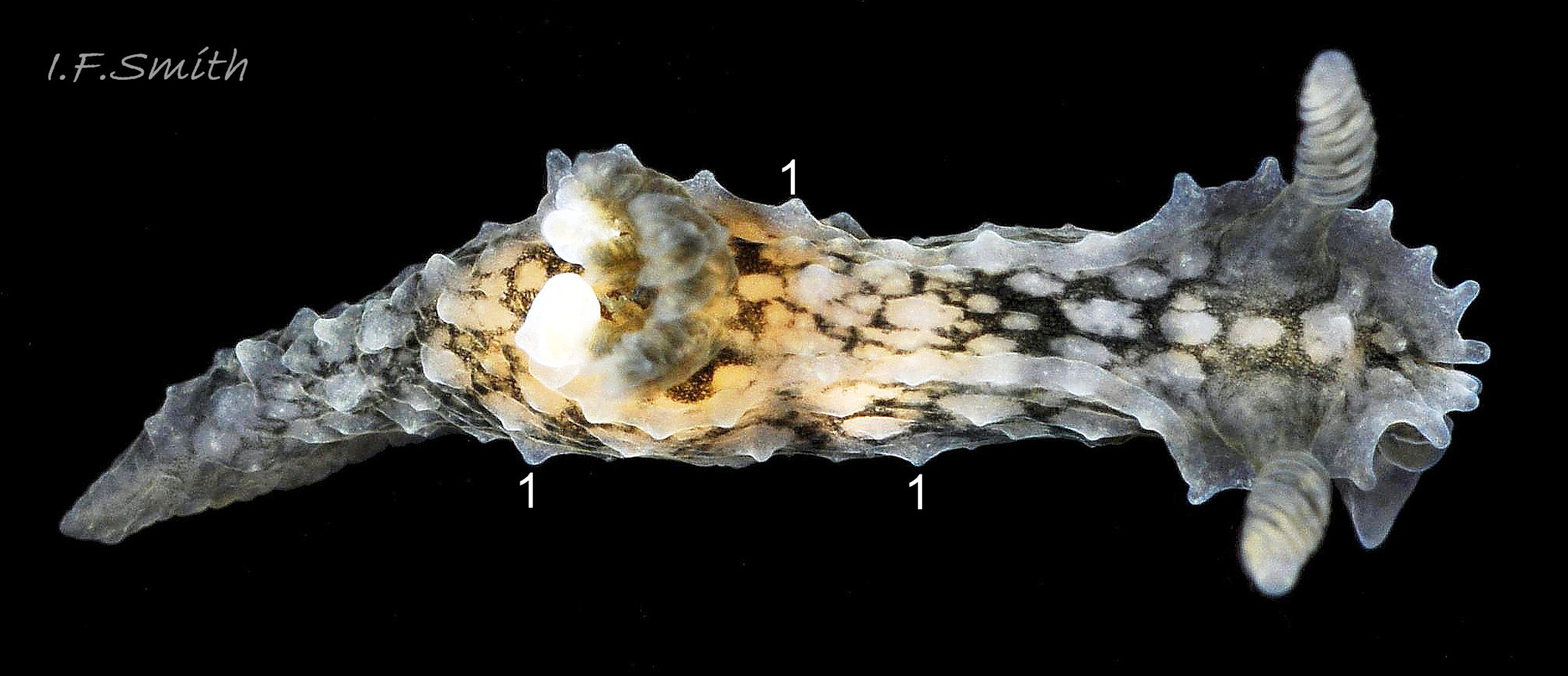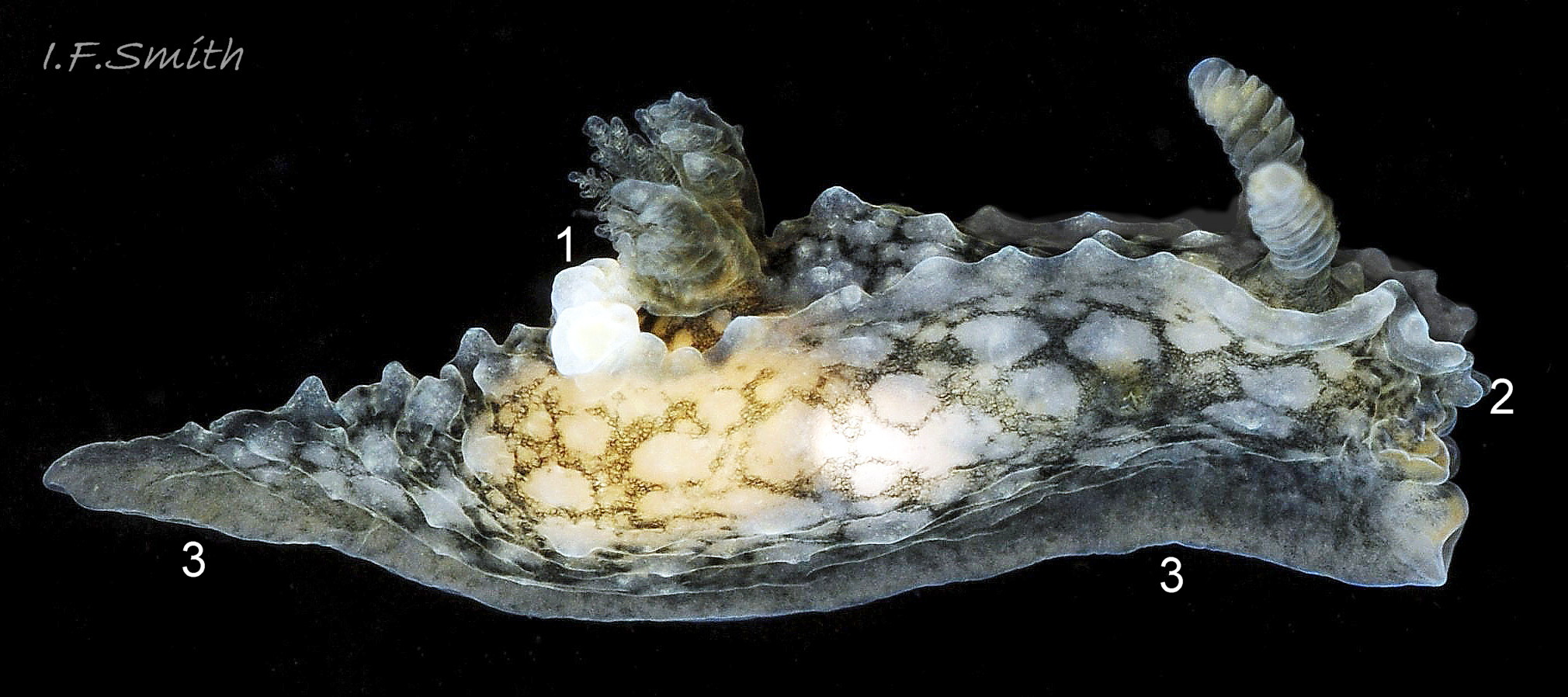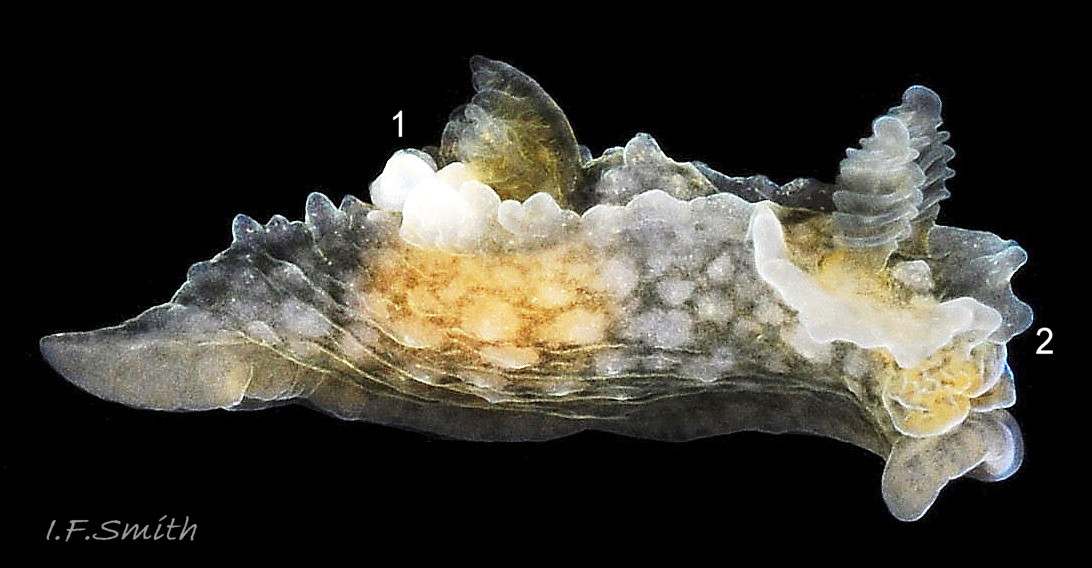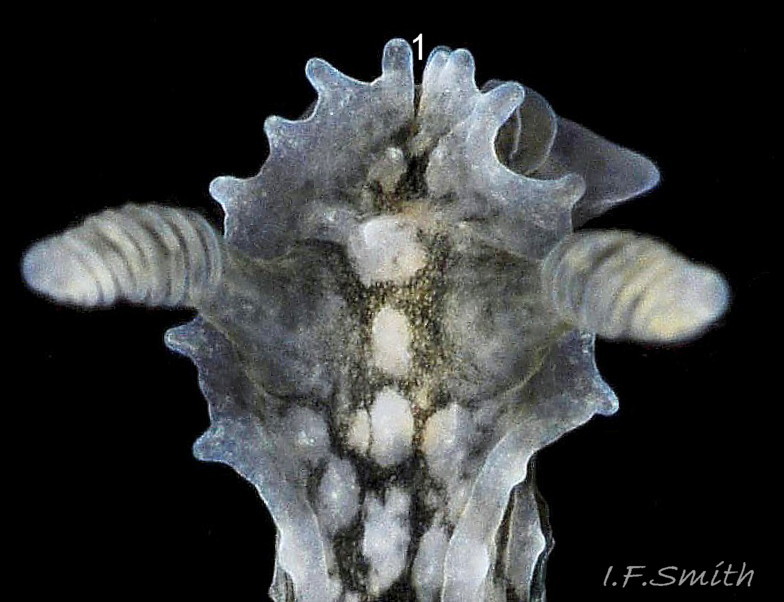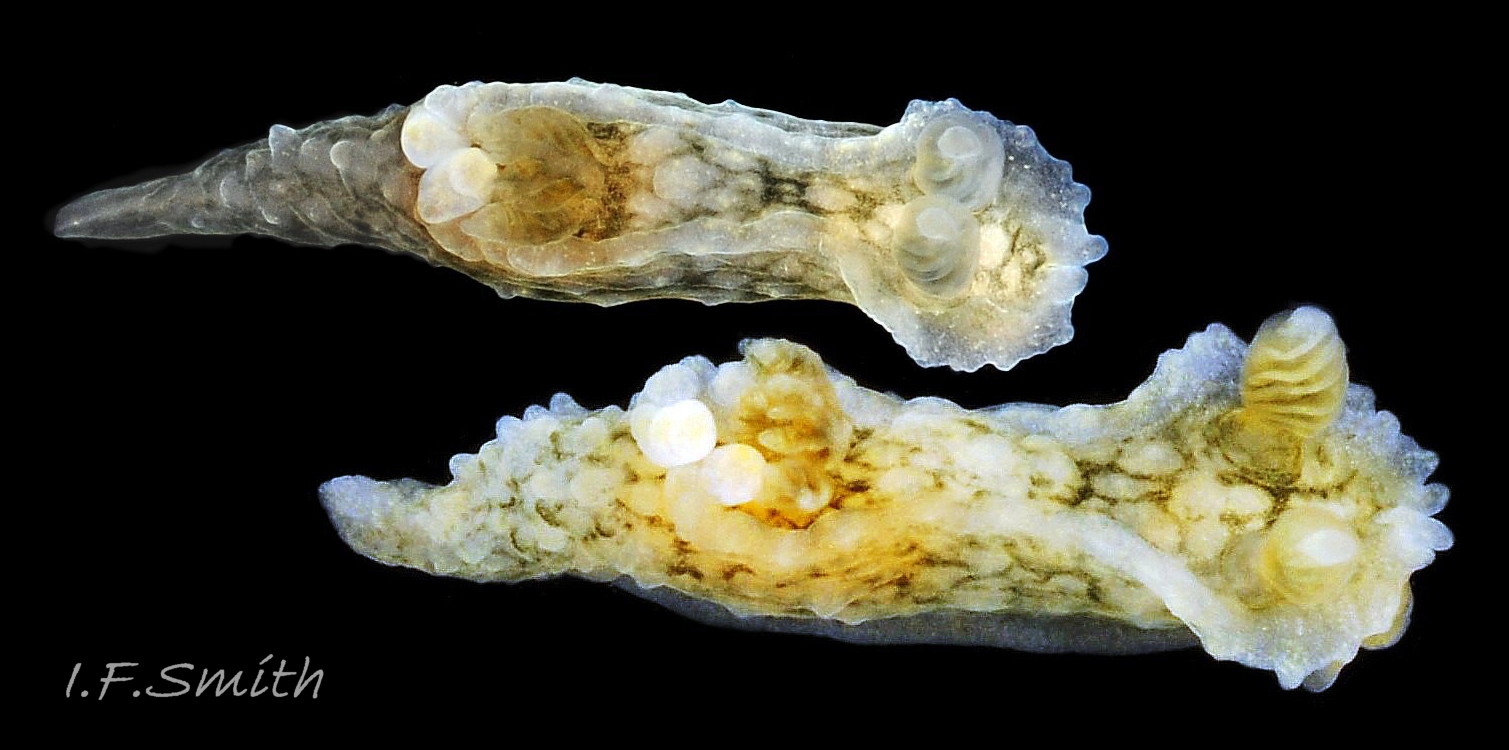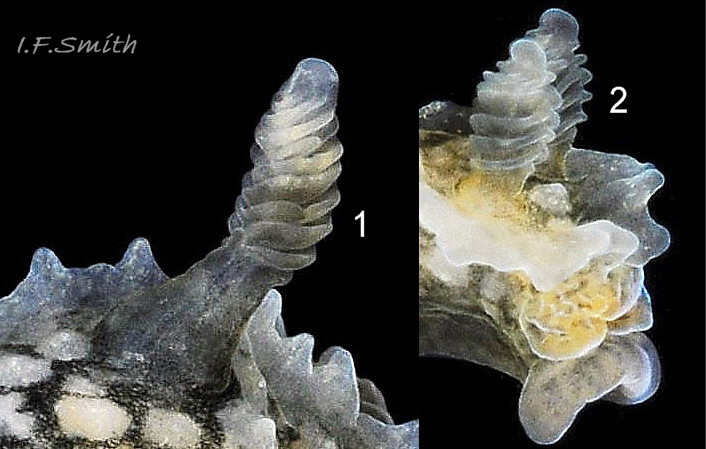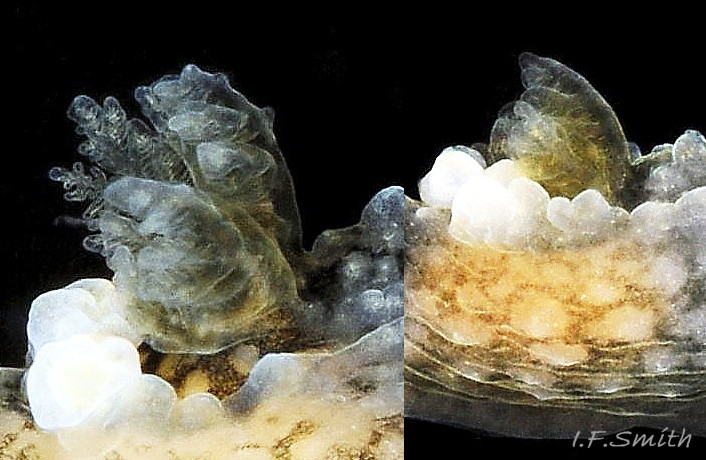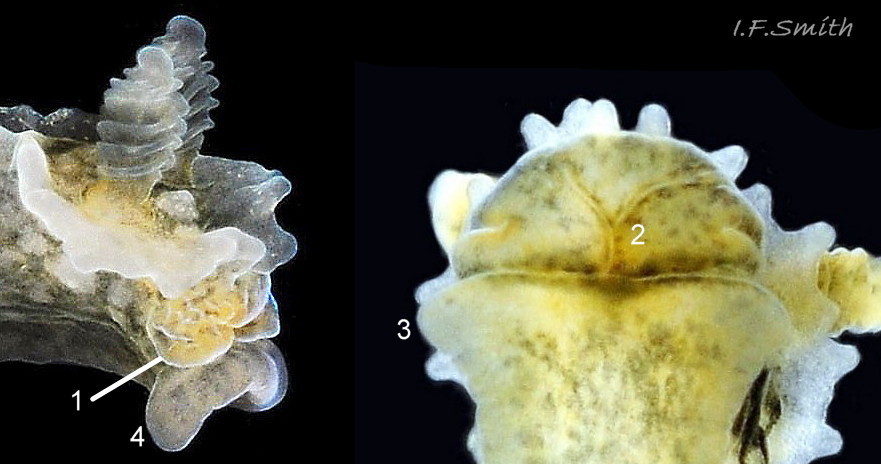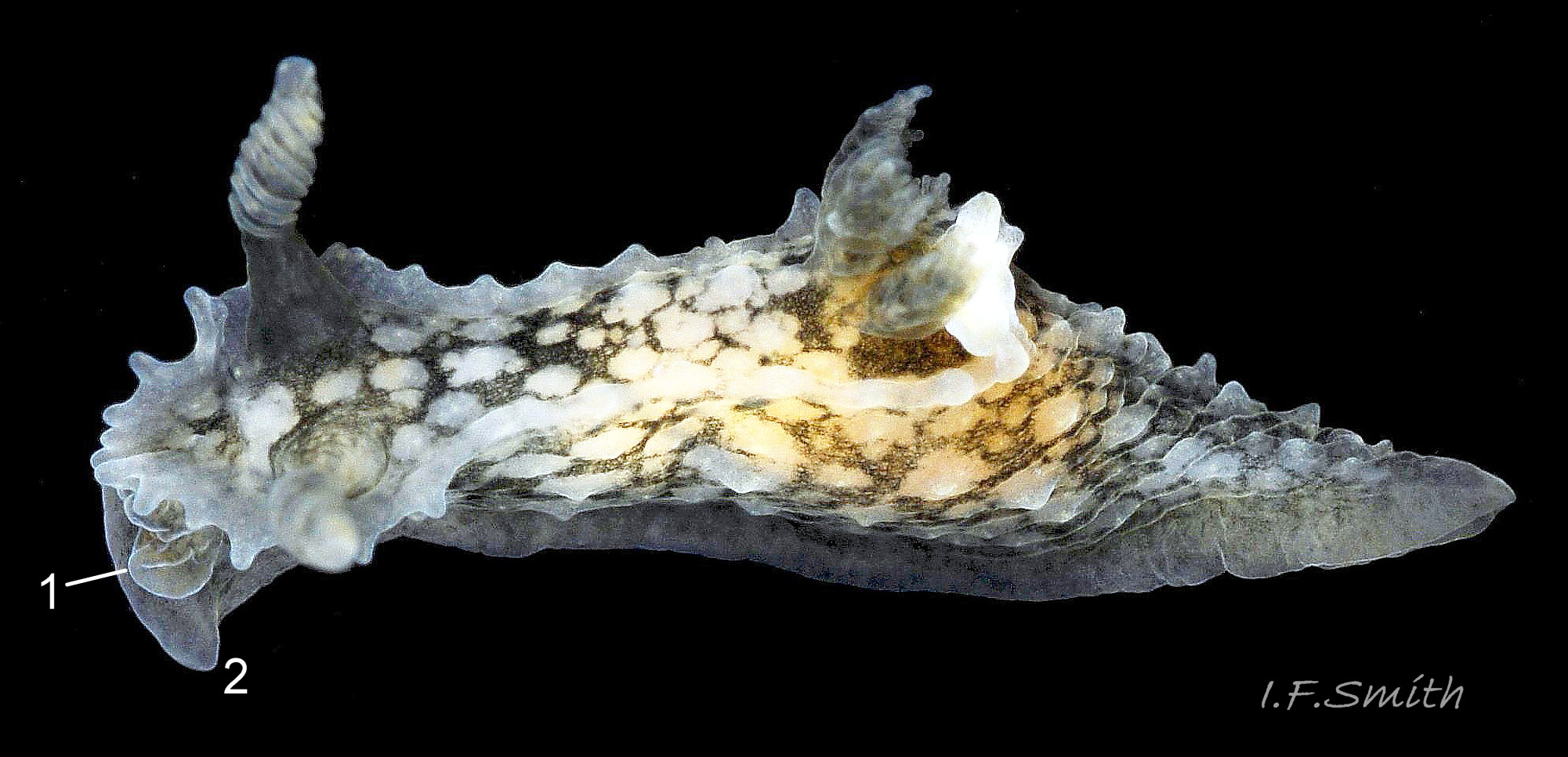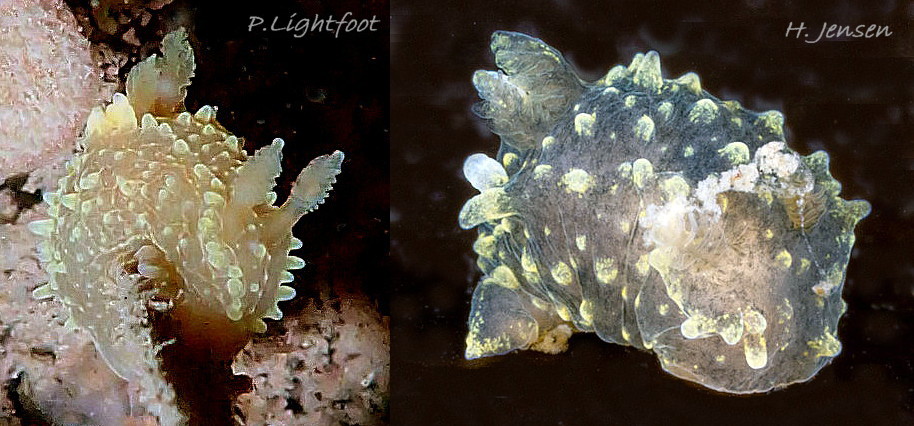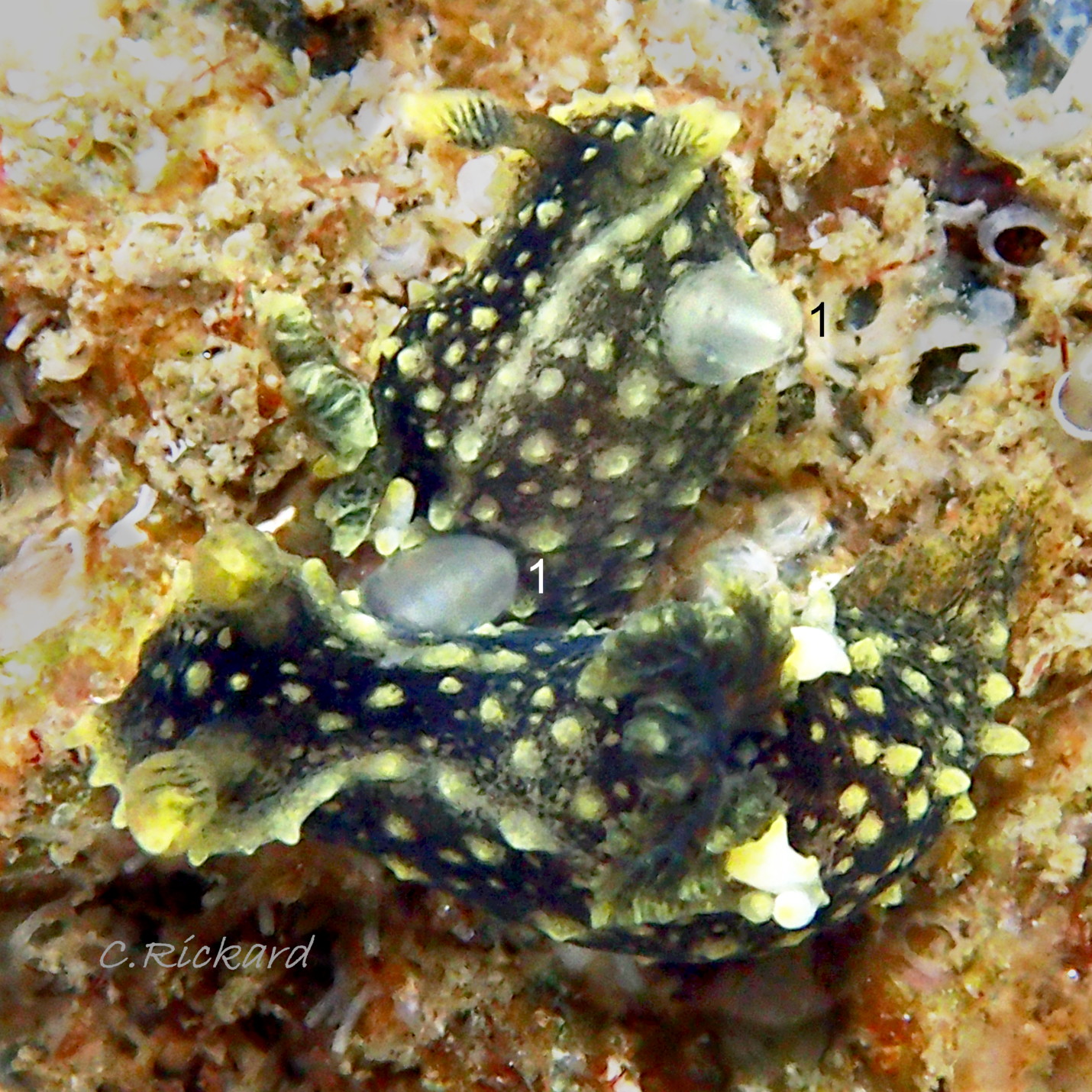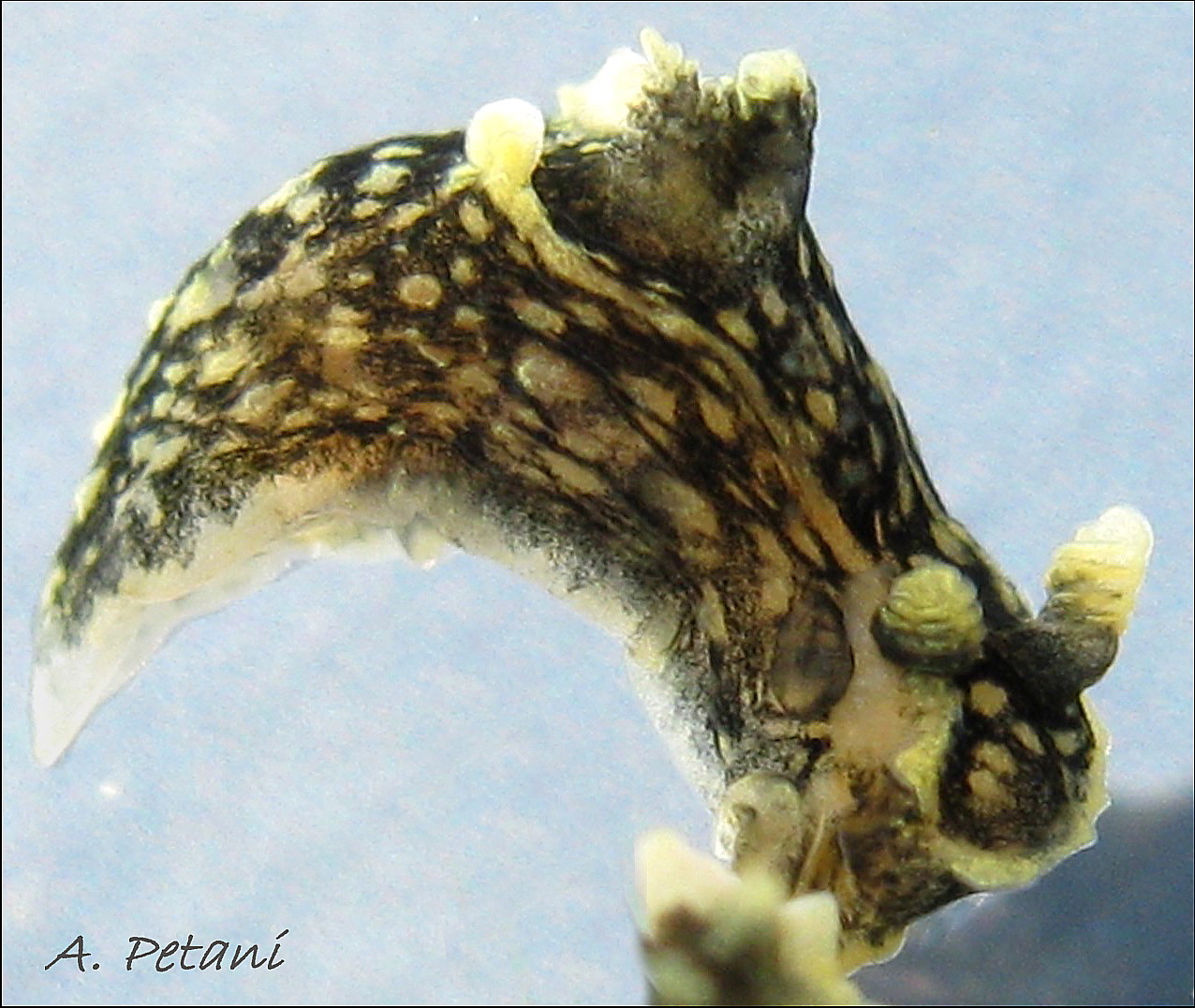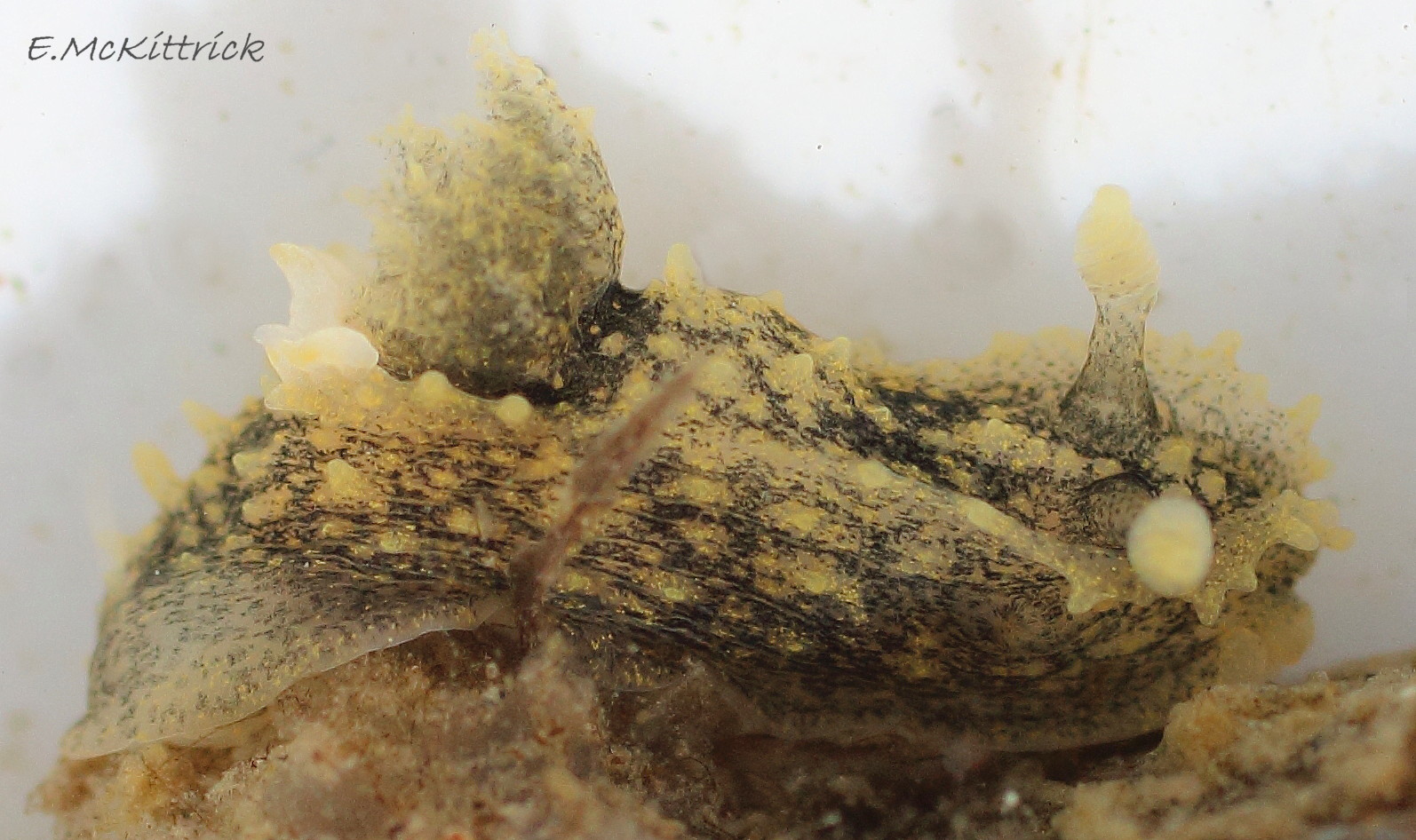Click image to enlarge with full caption. Main text below slider.
Palio nothus (G. Johnston, 1838)
PDF available at www.researchgate.net/publication/359802329_Palio_nothus_G…
Current taxonomy: World Register of Marine Species www.marinespecies.org/aphia.php?p=taxdetails&id=182808
Synonyms: Triopa nothus G. Johnston, 1838; Polycera ocellata Alder & Hancock, 1842.
GLOSSARY BELOW
Description
The slender body of P. nothus grows up to 20 mm long. It tapers to a posterior point, and widens by the rhinophores and gills 01 Palio nothus . The reduced mantle has a prominent free rim with many protruding whitish tubercles. The rim runs along each side of the body from a bright white lobe behind the gills 02 Palio Nothus & 03 Palio nothus to the anterior where it forms an anterior veil with about eight short, pale lobes. The left and right rims do not meet at the anterior so the veil has a narrow central gap 04 Palio nothus .
The translucent white flesh looks yellowish where it overlies coloured viscera 03 Palio nothus , and much of it is covered with very dense, minute, freckling of black pigment 04 Palio nothus which often creates an optical illusion of dark olive green. The pigmented areas are broken into a network by numerous, large, un-pigmented spots 02 Palio Nothus , each bearing a broad based, sharp tipped tubercle 01 Palio nothus , which can be depressed or raised. As they are translucent, the spots are yellowish when over coloured viscera. The black pigment develops with age, so juveniles are generally paler than adults 05 Palio nothus .
The tall rhinophores 06 Palio nothus are coloured as the body, with black mainly on the smooth conical base and lower lamellae. There are 7- 9 widely spaced lamellae on adults. The pale, translucent apex protrudes well clear of the lamellae. On 5 mm long juveniles, the stem is shorter, and there are about 5 lamellae.
There are three partially tripinnate gills 07 Palio nothus near the highest point of the dorsum. Sometimes there are two much smaller ones at their base. On adults they are usually a similar colour to the dark parts of the body. On young ones they are often paler 05 Palio nothus .
Most of the visible head consists of large, swollen lips/lobes 08 Palio nothus which may protrude laterally as folded flattened lobes 09 Palio nothus . When adhering to a flat substrate, the head is, semicircular, yellowish mottled dull green and the divisions of the flattened mouth parts form a Y. Dorsally, the mantle rim forms the lobed anterior veil 04 Palio nothus .
The slender, linear foot tapers to a posterior point 10 Palio nothus , and the corners of the truncated anterior can vary between slight propodial expansions and distinct, stout propodial tentacles 08 Palio nothus , 09 Palio nothus & 11 Palio nothus . The sole is yellowish mottled with dull green, and its translucency reveals fawn viscera below the gills 10 Palio nothus . The dorsal surface of the foot periphery forms a grey-white band sprinkled lightly with minute black (apparent dull green) specks 02 Palio Nothus . The foot may fold together when removed from its thin stemmed bryozoan prey 11 Palio nothus .
Key identification features
Palio nothus
1) Black (apparent dark green) pigmented areas broken into an ocellated network by numerous, large unpigmented spots bearing broad-based conoid tubercles 01 Palio nothus & 02 Palio Nothus .
2) Adults have 7-9 well spaced lamellae on each rhinophore (five on 5 mm juveniles) 06 Palio nothus .
3) Usually intertidal, sometimes sublittoral to 30 m.
4) Scattered finds around Britain and Ireland.
Similar species
Palio dubia (M. Sars, 1829) 12 Palio nothus .
1) Pale, narrow-based tubercles do not break the translucent, pale greenish-yellow flesh into an ocellated network. Some have evenly coloured translucent blackish flesh which should not be confused with the blotchy black pigment on P. nothus.
2) Up to 13 closely packed lamellae on rhinophore.
3) Sublittoral, rarely if ever intertidal. Many records confuse/combine P. dubia and P. nothus, all littoral records in Britain are dubious unless supported with an image.
4) North European species with reliable records as far south as Scotland, Northern Ireland and North-east England. (Many more-southern records confuse/combine P. dubia and P. nothus.)
Palio cf. nothus from Pacific coast of North America 15 Palio nothus
CO1 sequences of Palio specimens from the Canadian Pacific were 8% different from Norwegian P. nothus.
Habits and ecology
P. nothus lives at lower levels on rocky shores, and sometimes sublittorally to 30 m, feeding on Bowerbankia spp. It is difficult to detect on the shore and is best sought by examination under magnification of sessile bryozoans in water. It is a simultaneous hermaphrodite 13 Palio nothus . The spawn mass is a laterally compressed cylinder deposited from April to September in a loose angulated, white or rose-tinted coil around Corallina or a similar support.
Distribution and status
P. nothus is recorded from Britain, Ireland, the Netherlands, southern Sweden and southern Norway; GBIF map www.gbif.org/species/2291785 and from Galicia, Spain (Trigo et al, 2018). Thompson and Brown (1984) state it “is certainly an amphi-Atlantic, boreo-arctic species”, but there are no records from Atlantic America on GBIF or iNaturalist www.inaturalist.org/observations?taxon_id=499902 (accessed 2nd April, 2022).
There are scattered finds around Britain and Ireland. UK map species.nbnatlas.org/species/NBNSYS0000176948
Mediterranean records are few and uncertain because of confusion/combining of P. dubia with P. nothus, but it was correctly identified in 2011 from Croatia 14 Palio nothus . There are records from the Pacific coast of North America, and some look very similar to European specimens 15 Palio nothus COMPARE Pacific specimen. , but available molecular sequences (not necessarily of the species in image 15) are not identical with those of sequenced Norwegian specimens. CO1 sequences of Palio specimens from the Canadian Pacific were 8% different from Norwegian P. nothus and nearly 5% different from P. dubia (BOLD per K. Fletcher pers. comm. 2nd April, 2022).
Acknowledgements
I gratefully thank Heine Jensen, Paula Lightfoot, Erin McKittrick, Alen Petani and Chris Rickard for use of images, and Karin Fletcher for information on molecular sequencing.
References and links
Alder, J. & Hancock, A. 1842. Descriptions of several new species of nudibranchous mollusca found on the coast of Northumberland. Ann. Mag. nat. Hist.9: 31- 36 (p. 33 as Polycera ocellata)
www.biodiversitylibrary.org/page/2312453#page/47/mode/1up
Alder, J. & Hancock, A. 1845-1855. A monograph of the British nudibranchiate mollusca. London, Ray Society. Fam.1 pl. 23. www.biodiversitylibrary.org/item/131598#page/210/mode/1up
BOLD (Barcode of Life Data System) www.boldsystems.org/
Johnston, G. 1838. Miscellanea zoologica. Ann. Mag. nat. Hist. 1: 114-125. (page 124) at biodiversitylibrary.org/bibliography/4227#/summary
Nunn, J. 2006-2018 (accessed March 2022) Palio dubia – a nudibranch mollusc. Northern Ireland Priority Species. www.habitas.org.uk/priority/species.asp?item=643
Thompson, T.E. & Brown, G.H. 1984. Biology of opisthobranch molluscs 2. London, Ray Society.
Trigo, J.E.; Diaz Agras, G.J.; Garcia Alvarez, O.L.; Guerra, A.; Moreira, J.; Pérez, J.; Rolán, E.; Troncoso, J.S,; Urgorri, V.. 2018. Guia de los Moluscos Marinos de Galicia. Servicio de Publicacións da Universidade de Vigo.
Current taxonomy:: World Register of Marine Species www.marinespecies.org/aphia.php?p=taxdetails&id=182808
Glossary
digestive gland = large organ in gastropods which acts like the liver and pancreas in mammals to absorb food.
dorid = a sea slug in the infraorder Doridoidei; with gills and rhinophores on the dorsum; often shaped like half a lemon or grape.
hermaphrodite, simultaneous = individual acts as both male and female at the same time with similar partner(s).
lamellae = (of sea slugs) small plates on rhinophores or leaflets of gill.
mantle = (of nudibranchs) sheet of tissue forming part or all of notum (dorsal body surface).
oral veil = anterior extension of head into a flat sheet.
ovotestis = (pl. ovotestes) hermaphrodite organ serving as both ovary and testis.
propodium = anterior portion of gastropod foot. (adj. propodial).
rhinophore = chemo-receptor tentacle; many sea slugs have a pair on top of the head.
sessile = of immobile animals living attached to substrate, other animals, seaweed etc.
tripinnate = (of gill plume) threefold branching; “trunk, boughs, branches”.
veliger = shelled larva of marine gastropod or bivalve mollusc which moves by action of cilia on a velum (bilobed flap). Stage may be passed in plankton or within liquid-filled egg-capsule.
